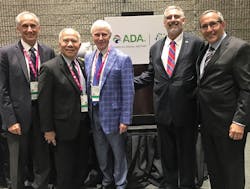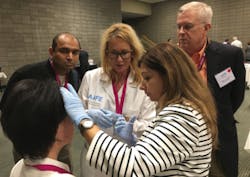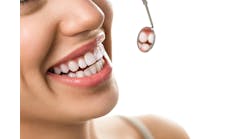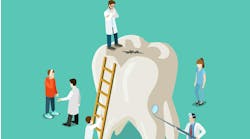Louis Malcmacher, DDS, MAGD
I just returned from the 2017 American Dental Association Annual Session (at the time of writing). Everyone reading this should plan to attend the ADA Annual Session because it brings an incredible array of dental continuing education together in one place. And this year, it will be in Honolulu—I hope to see you there!
At the 2017 meeting, I was honored to be part of an Ask the Experts panel, moderated by my longtime mentor and friend, Gordon Christensen, DDS, MSD, PhD, chairperson of Clinicians Report and Practical Clinical Courses. The members of the panel were Jon Suzuki, DDS, PhD, MBA, the former dean of University of Pittsburgh School of Dental Medicine and the current chairperson of the Food and Drug Administration Dental Products Panel; Michael Glick, DMD, the former dean of State University of New York at Buffalo School of Dental Medicine and the current editor of the Journal of the American Dental Association (JADA); Lee Silverstein, DDS, MS, FACD, FICD, a world-renowned dental educator, author, and periodontist; and yours truly (figure 1).
In a very fast two-and-a-half-hour session, a number of questions were asked about restorative, crown and bridge, and implant dentistry. Dentists also asked about the high costs of dental education, if private-practice dentistry has a future, and if dentistry is part of medicine. Here are some highlights from this excellent session.
Implants
What is the best implant system? Our expert panel thought the best implant system available is the one that works well in your hands. Dental professionals should be well trained before surgically placing implants, and CBCT should be considered for complex implant cases. Should the implant crown be screw-retained or cemented? There was significant agreement here: screw-retained implant crowns were highly preferred by the panel. Dr. Glick’s expertise in oral medicine was invaluable in this dental implant discussion.
Figure 1: (left to right) Dr. Michael Glick, Dr. Jon Suzuki, Dr. Gordon Christensen, Dr. Lee Silverstein, Dr. Louis Malcmacher
Restorative
Zirconia (BruxZir, Glidewell Dental) or lithium disilicate (e.max, Ivoclar Vivadent) crowns—which is best for anterior bridgework? Different experts had different answers. Is the patient a bruxer? What does the occlusion look like? When lithium disilicate breaks, is it the material, or is it the clinician who used it for the wrong situation? When polled by Dr. Christensen, the audience overwhelmingly said they use zirconia.
When asked about handpieces, Dr. Christensen and others quickly indicated a preference for electric handpieces, such as NSK Dental’s. Electric handpieces offer more control and better cutting than air-driven handpieces.
Cements were also discussed. For lithium disilicate restorations, I prefer Multilink Automix (Ivoclar Vivadent). Dr. Christensen suggested Panavia SA Cement Plus (Kuraray Dental) as an excellent all-around cement for lithium disilicate and zirconia crowns.
Figure 2: American Academy of Facial Esthetics (AAFE) live-patient training course at the 2017 ADA meeting
Botox and dermal fillers
Several questions involved Botox. I gave a brief explanation of the esthetic and therapeutic uses of Botox and dermal fillers. Dr. Christensen told a story about when he and I recorded a DVD training program about the uses of Botox. One of the patients treated was his assistant, Amy, who had suffered from TMJ, orofacial pain, and migraines for a number of years and had routinely missed two to three days a month because of her condition. Since her treatment three years ago, she has not suffered a relapse. So is Botox now a part of dentistry? Considering the story Dr. Christensen told and the American Academy of Facial Esthetics (AAFE) live-patient Botox training course that was offered at ADA 2017 (figures 2 and 3), every dentist should consider making Botox part of his or her practice.
Figure 3: AAFE faculty Suzanne Haley, DMD, shows an ADA attendee how to inject Botox properly.
Black triangles
Someone asked about the treatment possibilities for black triangles. It was interesting to hear the two periodontists, Drs. Suzuki and Silverstein, comment that black triangles are one of the most frustrating challenges in periodontics. I described the use of dermal fillers, such as Juvéderm and Restylane, which we use to replace midface volume and provide lip enhancements. I explained the American Academy of Facial Esthetics protocol for using these dermal fillers to add volume to the deficient interdental papilla and fill in black triangles. This treatment has become invaluable in treating black triangles, and it certainly intrigued the panel and audience.
The bottom line of this session was that dental professionals who want to expand their practices and offer more services need to be well trained to get the best treatment outcomes. Education is the key to success in dentistry. Get trained today!
Author’s note: Go to FacialEsthetics.org to sign up for a free monthly e-newsletter or for information about live-patient Botox and dermal fillers training, PDO threadlifts, frontline TMJ and orofacial pain training, bruxism therapy, and dental sleep medicine.
Louis Malcmacher, DDS, MAGD, is a practicing dentist and an internationally known lecturer and author. He is president of the American Academy of Facial Esthetics (AAFE) and serves as a consultant to STATDDS. Contact him at (800) 952-0521 or [email protected].










